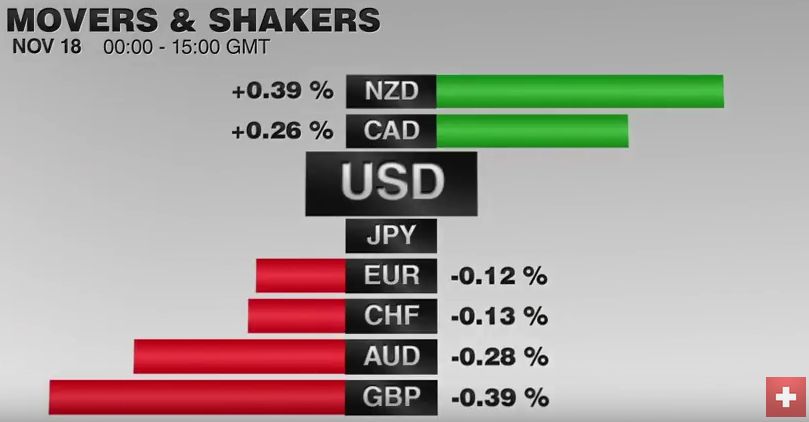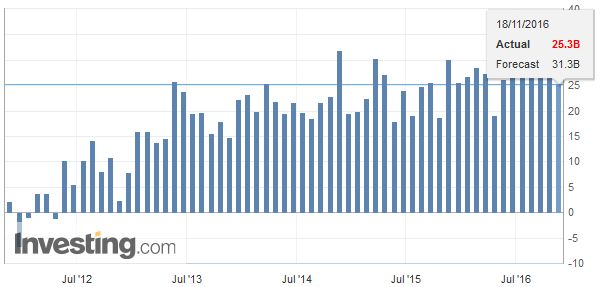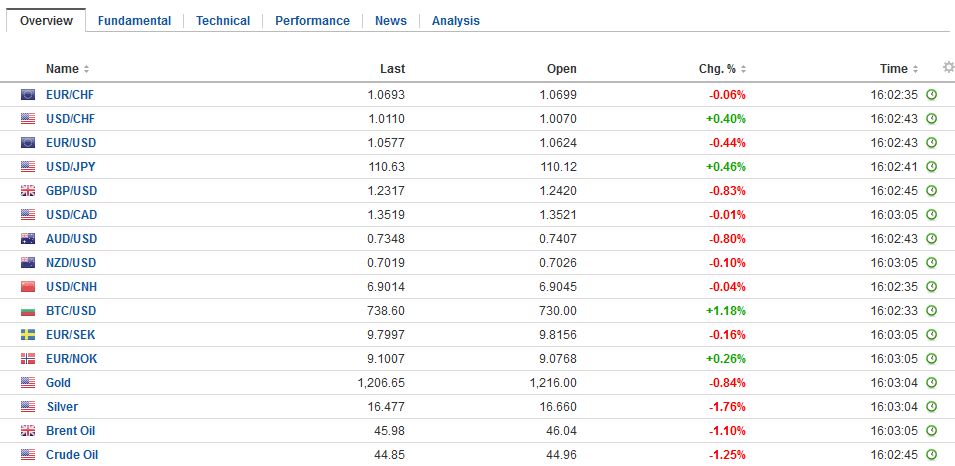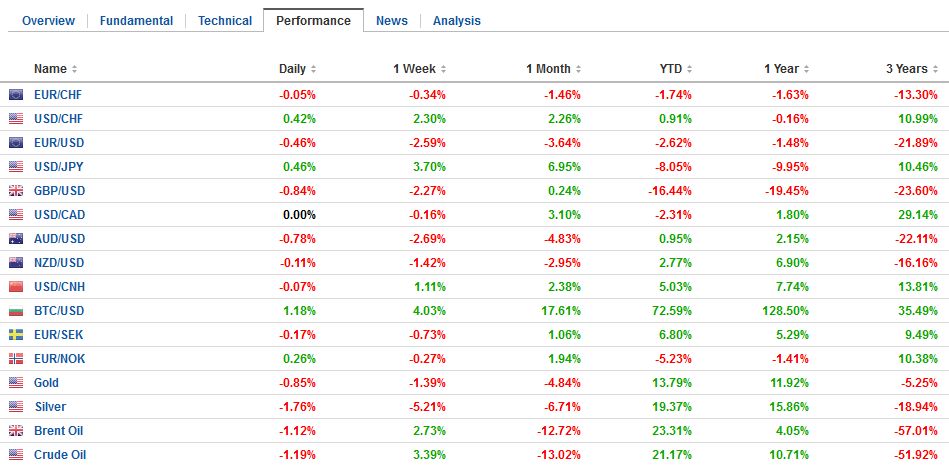Swiss Franc |
EUR/CHF - Euro Swiss Franc, November 18(see more posts on EUR/CHF, ) |
FX RatesSince the US election, the dollar has been on a tear. Pullbacks have been brief and shallow. There are powerful trends in place. The euro has fallen nearly five percent over the past ten sessions, during which it is not closed higher once. The dollar rose four days this week against the yen and four days last week. The dollar has risen a little more than 7% against the yen during this run to reach five-month highs by approaching JPY111 today. US 10-year yields have fallen once in the past two weeks. Above 2.30%, the yield is at its highest in nearly a year. The S&P 500 is within 0.3% of its record high set in mid-August. The yield on the 10-year German bund has doubled to 30 bp over the past two weeks. The 10-year JGB yield finished at two basis points, which is the highest on a weekly close in nine months. |
FX Performance, November 18 2016 Movers and Shakers . Source: Dukascopy - Click to enlarge |
| Many market observers are cautioning that investors are getting ahead of themselves. That a Fed rate hike next month has already been discounted. Like all politicians, and perhaps even more so given his irreverent campaign, the extent to which Trump fulfill his campaign promise, is unclear. Moreover, Trump often was seen campaigning against Republican’s in Congress, many of whom do not share his commitment to fiscal stimulus. These concerns fail to appreciate the watershed that is taking place. It appears that the three-decade secular decline in bond yields may be over. This is important and has far-reaching implications. At the very least, we are experiencing the biggest change in the investment climate since the Great Financial Crisis. |
FX Daily Rates, November 18 (GMT 16:02) |
| On top of this, being bitten by the same dog twice, surprising by the extent of the seeming nationalist/populist shift; first in the UK and then in the US, investors have turned a jaundiced eye toward Europe While the nationalism/populism has altered the course of these two countries, it may be an acid the dissolves the glue that binds Europe together. Italy’s constitutional referendum and the Austrian presidential election in early December seem to be appetizers for the main course, the French presidential election in the Spring, in which the odds of the National Front winning seem to be rising.
The euro was pushed through $1.06 but has stabilized in the European morning. It continues to struggle to sustain even modest upticks. The next targets are the lows from last year seen in the $1.0460-$1.0525 area. At JPY110.35, the greenback retraced half of this year’s loss against the yen. The JPY112.45 area corresponds to a retracement objective of the entire slide from last year’s high. Sterling is consolidating, with losses against the dollar muted by gains on the crosses. Sterling test and held the week’s low near $1.2380. Sterling has not traded below its 20-day moving average since 1 November, and it is found near $1.2370. The Australian dollar has fallen out of favor. It was repeatedly turned back from the $0.7700 area and is finishing the week at its lowest level since June. It has lost nearly 2% this week and was sold through $0.7400. The $0.7330 area represents a 50% retracement of this year’s rally off the January low near $0.6830. |
FX Performance, November 18 |
EurozoneFor his part, Italian Prime Minister Renzi has again renewed this threat to resign if the referendum loses. He disdains the possibility of heading a caretaker government, which he says always raises taxes. The referendum appears to be losing support, and there is already a discussion of likely candidates to replace Renzi. The Cultural Minister Franceschini and Finance Minister Padoan are being touted. Whoever it is would be the fourth unelected Prime Minister. Some suspect Renzi could consider calling for a snap parliamentary election. The problem is that without the referendum being approved, the Italian political system is in disarray. Reforms approved earlier this year, change the way the lower house is elected. Extra seats are given to the party/coalition that receives the most votes. Ostensibly this is to facilitate stronger governments. The Senate was excluded from the new rules and was to be reformed (reduced in size and scope) by the referendum. Italian bonds fared better than Spanish and Portuguese bonds this week. The Italian 10-year yield rose three basis points. Spain’s rose 12 bp and Portugal more than 22 bp. In contrast, the yield on the 10-year bund slipped one or two basis point this week. On the other hand, Italian bank shares performed miserably. The index of Italian bank shares fell each session this week for a cumulative loss of nearly 11%. In contrast, the bank sub-index of the Dow Jones Stoxx 600 is set to eke out a small gain (~0.2%) after gaining 7.5% the previous week. |
Eurozone Current Account, October 2016(see more posts on Eurozone Current Account, ) . Source: Investing.com - Click to enlarge |
Germany |
Germany Producer Price Index (PPI) YoY, October 2016(see more posts on Germany Producer Price Index, ) . Source: Investing.com - Click to enlarge |
CanadaThe Canadian dollar is the only major currency points to squeeze out a gain against the US dollar this week. Oil is snapping a three-week decline, and some cross rate plays (in a strong US dollar period, the Canadian dollar tends to gain on the cross against the other major currencies). However, Canada also cannot keep pace with the backing up of US rates. The US premium on two-year money increased six basis points this week to 36 bp. the most in 10 months. |
Canada Consumer Price Index (CPI) YoY, October 2016(see more posts on Canada Consumer Price Index, ) . Source: Investing.com - Click to enlarge |
The widening of the premium offered by the US continues to enhance the incentives to be long dollars. The yield picks up gained by holding two-year US notes over Germany stands at 167 bp now. It is up 15 bp this week and was trading near 145 bp at the start of the month. It is the most in several years. The 10-year premium has risen by nearly 50 bp since the end of October to just below 300 bp.
The US two-year premium over Japan is at 120 bp. It is the most in eight years. It has increased by 13 bp this month. The 10-year premium is near 228 bp, which is 40 bp higher than at the start of the month.
Graphs and additional information on Swiss Franc by the snbchf team.
Full story here Are you the author? Previous post See more for Next postTags: #USD,$AUD,$CAD,$EUR,$JPY,Canada Consumer Price Index,EUR/CHF,EUR/GBP,Eurozone Current Account,Germany Producer Price Index,newslettersent,SPY









































